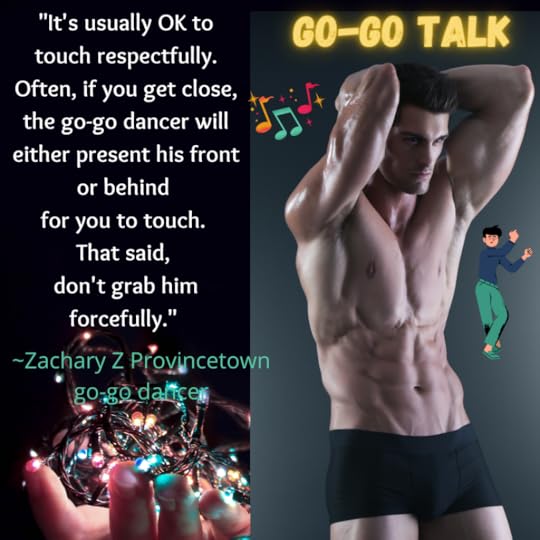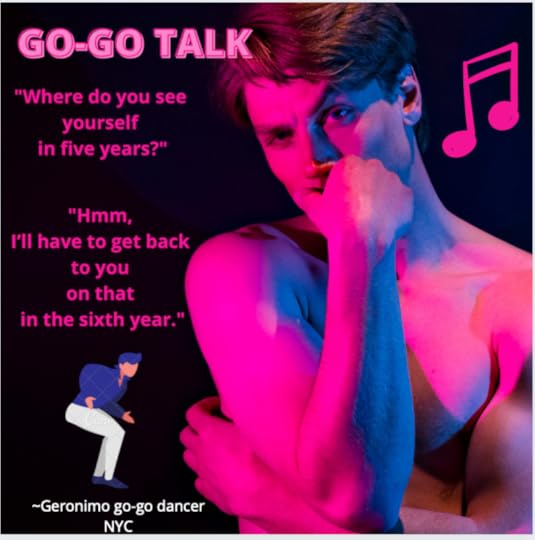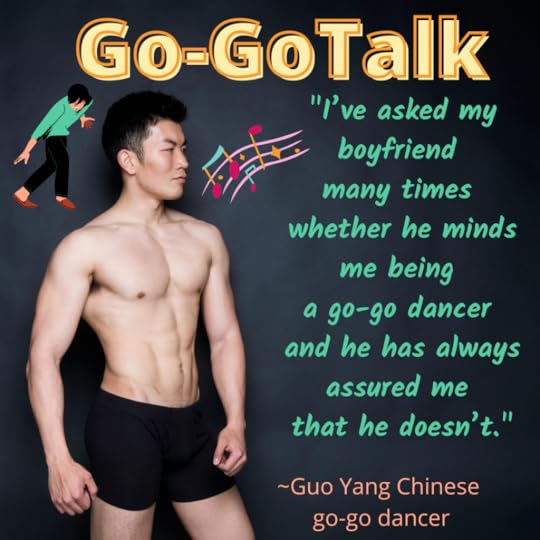GO-GO boys: an inspiration for “Dimmy” in WHATEVER HE NEEDS

“The scenery I’m so eagerly soaking up is of the human variety. In particular, the barely legal go-go boy named Dimmy, who’s gyrating his unnaturally flexible body on top of a glowing lime-green cube set up dead center of the dimly lit, jam-packed dance floor. At the moment, he’s dancing—if you can call it that—to a smoky 80s tune.” (Whatever He Needs)
 Dimmy on the lit-up cube[image error]
Dimmy on the lit-up cube[image error]One of the two leading men in Whatever He Needs, my May 4th Contemporary Gay Romance releasing from Boroughs Publishing Group, is Dimitri Cirillo, AKA Dimmy. He’s a go-go dancer at All the Feels Lounge, a shabby gay bar in rustic Millbank Square.
Here’s the preorder link, if you’ve gotta grab WHATEVER HE NEEDS RIGHT NOW!!!
https://www.boroughspublishinggroup.com/books/whatever-he-needs
Dimmy didn’t freely choose to be a go-go dancer, as did many of the subjects I came across in my research who chose go-go dancing as a means of acquiring “quick and easy” money. He is coerced to entertain in his father’s bar—dancing on a lime green, lit up cube set in the center of the dancefloor—as it’s expected that he’ll do whatever is necessary to earn his keep. His demanding father, Gregory Cirillo, confiscates all of his tips in exchange for allowing his son to live in a tired room above the bar.
Although go-go boys are an entertainment fixture in many gay (and other) social scenes around the world, I used the author’s creative license in my creation of Dimmy’s role as a club dancer at All the Feels. He performs, scantily clad and in a highly titillating manner, but his role at his father’s bar differs from that of many other go-go dancers.

“I get paid to go out and drink and be the center of attention, rather than paying to go out and drink and trying to get people’s attention.” (Jeff Tetreault, West Hollywood)

In order to get a good grasp on go-go dancing, I researched the experiences of both male and female club dancers.I soon realized that there are many differences between their experiences. To start, with female go-go dancers there seems to be a greater focus on creative costuming—rhinestones and miniskirts and torn bodysuits—where most male dancers merely wear designer underwear and jockstraps. There is generally more distance between the female dancer and the customers. Less touching is allowed, and female dances frequently are provided with security, so it’s more often a visual performance than a physical one. “I never had to do anything ‘gross’, like touch anyone or let them touch me, though there were some instances where men got handsier than I would have liked…” says former go-go dancer, Jessica Delfino.

The experience of male go-go dancers is closer to a stripper’s experience. Touching and even groping is commonplace, and even expected. “Cash bursting out of every pelvic fold they’re equipped with, they’re aggressively vying for all of the eyes and dollars in the room,” describes Jeff Tetreault, the West Hollywood go-go boy. Tetreault must provide his own security, as well. In other words, he protects himself from the sometimes aggressive crowds. “I’m essentially a zoo animal.” And Tetreault admits to being desensitized to the grabbing. “You know people think because they have a dollar bill they have a magic wand of some sort.” In addition, Tetreault admits to feeling quite competitive with the other go-go boys. “I want to look the best I can, have the best bulge, and I want to earn money. I don’t want to be outdone by someone. I don’t like when I see another dancer get more attention.”

Zachary Zane, a Provincetown MA, go-go dancer, offers words of wisdom for gay men who attend performances. Touching respectfully, according to him, is acceptable, but there are limits. “I told you it was OK to touch, but let’s not take a mile when I gave you an inch…or eight.” In other words, customers shouldn’t squeeze too hard or hang on too long.


Alcohol and drug consumption is common among both male and female club dancers. One male dancer reports that in his circles there is a lot of drug use among dancers, including weed, cocaine, and Viagra, as well as injections to make them stay erect. Female dancers do not have to concern themselves with drugs to make them appear sexually aroused, but they also report the party aspect of this lifestyle as a major draw. Diana Brownie, a Canadian ski town former go-go dancer said, “I had graduated (university)….and didn’t really want to grow up. Whistler is like Never Never Land for adults.” Another dancer said, “My favorite part was the party…”

In my research, I also viewed several episodes of YouTube’s Go-go Boy, Interrupted about a male go-go dancer who aged out of the scene. Jimmie Fowlie asserts that club dancing encouraged a long span of party life with not much to show for it on the other side.

For many dancers, alcohol and drug dependence are some of the most serious long-term downfalls of the club dancing lifestyle. Delfino suggests that it was also a hard lifestyle to withdraw from, as the money was fast and easy to earn. She felt she had needed guidance that she didn’t receive during this time in her life, as Delfino was hiding her go-go dancing career from her family. She kept going into debt when working other jobs and then then would return to go-go dancing to make the bigger, quicker money.

Many dancers, in fact, feel they need to keep their go-go dancing life secret from family, but when asked directly if they’re ashamed of their job, their response was largely no. Tetreault says, “It’s not something I’m ashamed of. I see it as part of my journey. It’s my job—it isn’t my identity.” And Delfino asserts that it actually brought her confidence. “Getting on stage for the first time was petrifying and exhilarating in the same moment.” At first, she was shy, but her confidence quickly grew when she realized she could throw off her fears and do anything to survive, even something taboo. “I didn’t feel like I was doing anything wrong. I didn’t feel naughty. I didn’t feel bad. I didn’t feel creepy. I felt like a young woman who wanted to go to school…”

One of the trickiest aspects of go-go dancing is the constant propositions by customers for services that can be described as “more than dancing.” Guo Yang, one of Asia’s most popular go-go boys reports that “It’s quite common to receive sexual requests, which is understandable considering the nature of our performances. But it’s all about how you deal with it…If the request is too weird, you are always free to reject it. The weirdest request I’ve received was people asking me for my worn underwear.” One dancer calls the offering of these extra requests “privates”, where you go back to a private location with a client to cuddle or engage in sexual activity.

Another negative effect of working as a go-go dancer is the societal judgment one must deal with. Tetreault says, “I get very insulted when people like to call me a hooker, whore, prostitute, or man-whore because I don’t do that stuff…” A go-go boy reports, “I have heard the most absurd things you can imagine for being a go-go dancer. Many of us have a degree and a nine to five job. We are just normal people with a slightly unconventional job. But in the end it doesn’t matter because we are surrounded by friends and don’t really want to be close to people with little, simple minds anyway.” Guo Yang states, “People generally have a negative perception of go-go dancers…A lot of people are under the impression that go-go boys are motivated purely by money and would accept sexual requests but that is just a stereotype and cannot be generalized to everyone.” Jessica Delfino’s mother kicked her out of the home when she learned how her adult daughter was paying her college tuition. And there are other repercussions to go-go dancers functioning prominently in certain aspects of society. Does it encourage unrealistic body image stereotypes? Does it encourage people to use sexuality to gain money and attention? These are fair questions.

My character, Dimmy, endures many of these experiences as a go-go dancer in Whatever He Needs. Although he stands on a two-foot-high cube when he performs, he must constantly evade the physical attention of customers—inside and outside of the bar. He is judged harshly for being a go-go dancer, as if what he’s doing to pay the bills is shameful; even his lover, Liam, initially is ashamed by the prospect of introducing Dimmy to his very upscale family.

Dimmy feels embarrassed and humiliated by his job more than the dancers I researched because it’s not his choice, but something his father requires of him. And Dimmy is not allowed to keep his tips, which is the lifeblood of club dancer. More recently in the story, his father is starting to introduce Dimmy to “privates” where he’s required to do more than dance. This is why Dimmy is forced to make some very tough choices about how he is living and what he’s willing to do to to survive.
Although the money may be called “easy” life as a go-go dancer is quite challenging.

[image error]
“When Alanis Morissette breaks into her pissed-off vocals, it’s as if Dimmy has been wound up by an invisible crank on his back. He straightens and starts to move, his dancing more indecent than it was before his encounter with Gregory. The sleek body on the glowing cube twists into sensual shapes, flexing and grinding without inhibition. Even his face has become part of the show. Dimmy now stares without focus into the crowd of men, who are again drawn to him like moths to a flame. Eyelashes fluttering and lips forming shapes more suitable to the bedroom than the stage, he’s bold and provocative and captivating.” (Whatever he Needs)






